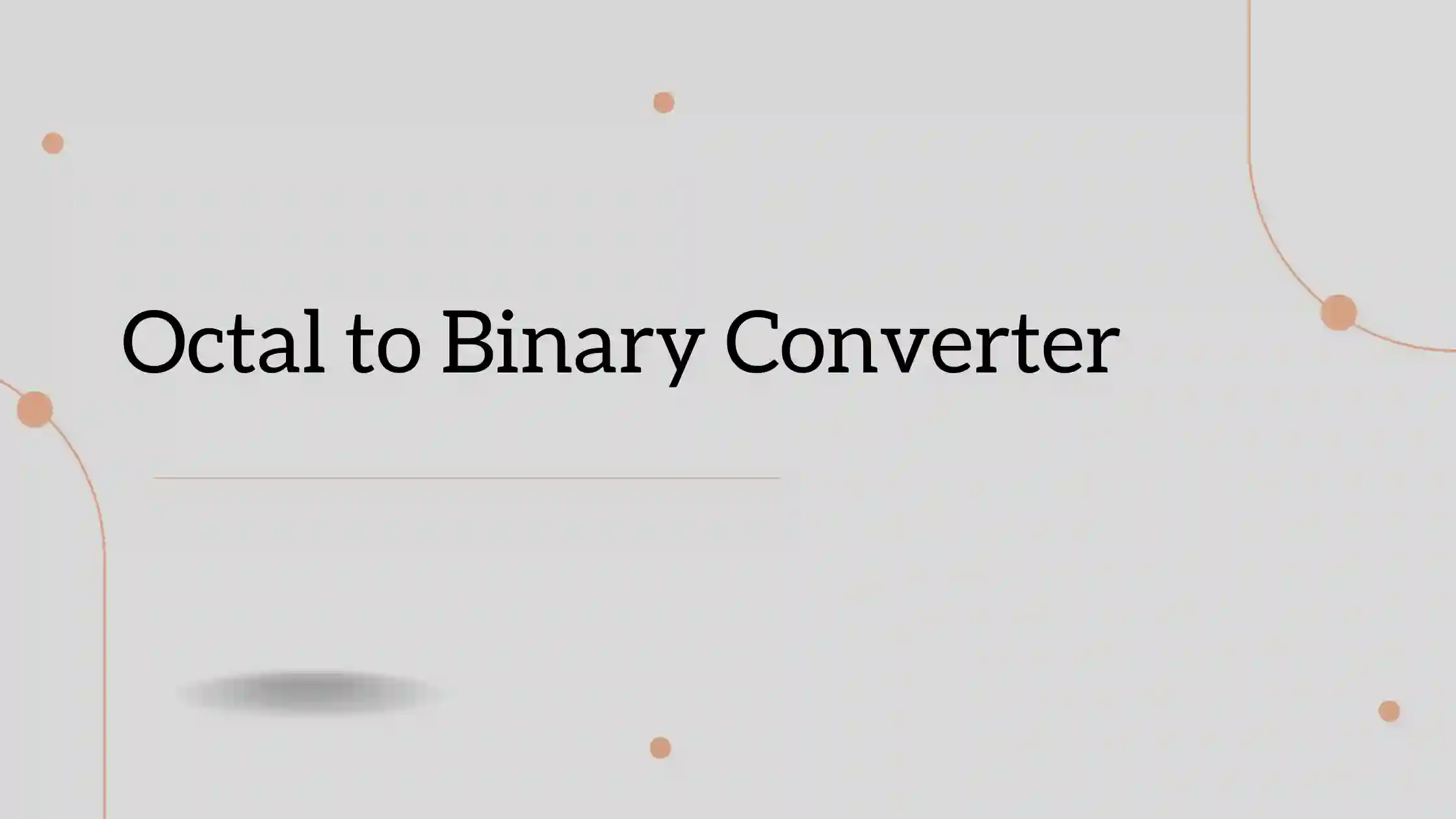Octal to Binary Converter
Octal to Binary Converter: Simplifying Number Conversion

In the digital age, understanding number systems is fundamental, especially when it comes to working with computers and digital devices. Octal to binary conversion is a crucial skill for anyone delving into the world of programming, as it allows for seamless communication between humans and machines. In this comprehensive guide, we will explore the concept of converting octal numbers into binary form, making it easy to grasp even for beginners.
Table of Contents
- Octal to Binary Converter: Simplifying Number Conversion
- 1. Introduction
- 2. What is Octal?
- 3. What is Binary?
- 4. Why Convert Octal to Binary?
- 5. Understanding the Octal Number System
- 6. Understanding the Binary Number System
- 7. The Conversion Process
- 8. Step-by-Step Conversion Example
- 9. Tips for Quick Conversion
- 10. Applications of Octal to Binary Conversion
- 11. Challenges and Common Mistakes
- 12. Conclusion
- 13. FAQs
1. Introduction
In the realm of computer science and programming, numbers are often represented in different numeral systems. Two of the most prevalent systems are octal and binary. Octal is base-8, while binary is base-2. Converting between these systems is essential for various tasks, and we'll explore this process in detail.
2. What is Octal?
Octal is a numeral system that uses eight distinct symbols, namely 0, 1, 2, 3, 4, 5, 6, and 7. Just like our familiar decimal system (base-10), octal represents quantities using powers of eight.
3. What is Binary?
Binary is the language of computers, consisting of just two symbols, 0 and 1. It is a base-2 numeral system, making it ideal for electronic devices that work with on/off switches.
4. Why Convert Octal to Binary?
Converting octal numbers to binary is essential when dealing with computer data, coding, and digital circuitry. Many times, it's necessary to translate octal values into binary for precise instructions to be executed by a computer.
5. Understanding the Octal Number System
Before we delve into the conversion process, let's familiarize ourselves with the octal system. Octal digits, as mentioned earlier, range from 0 to 7. Here's an example: the octal number 53 is equivalent to (5 * 8^1) + (3 * 8^0) in decimal.
6. Understanding the Binary Number System
Binary is simpler, with only 0 and 1 as digits. It operates on powers of 2. For instance, the binary number 101 is equivalent to (1 * 2^2) + (0 * 2^1) + (1 * 2^0) in decimal.
7. The Conversion Process
To convert octal to binary, we'll follow a two-step process: first, converting octal to decimal, and then converting decimal to binary.
7.1. Converting Octal to Decimal
- Write down the octal number.
- Assign powers of 8 to each digit from right to left.
- Multiply each digit by 8 raised to its respective power.
- Sum up the results to obtain the decimal equivalent.
7.2. Converting Decimal to Binary
- Divide the decimal number by 2.
- Record the remainder (0 or 1) as the least significant digit of the binary representation.
- Continue dividing the quotient by 2 until it becomes 0, recording remainders along the way.
- Write down the remainders in reverse order to get the binary equivalent.
8. Step-by-Step Conversion Example
Let's convert the octal number 72 to binary using the steps outlined above:
Step 1: Octal to Decimal
- 7 * 8^1 = 56
- 2 * 8^0 = 2
- Sum: 56 + 2 = 58
Step 2: Decimal to Binary
- 58 divided by 2 is 29 with a remainder of 0.
- 29 divided by 2 is 14 with a remainder of 1.
- 14 divided by 2 is 7 with a remainder of 0.
- 7 divided by 2 is 3 with a remainder of 1.
- 3 divided by 2 is 1 with a remainder of 1.
- 1 divided by 2 is 0 with a remainder of 1.
Reading the remainders in reverse order gives us the binary equivalent: 1001000.
9. Tips for Quick Conversion
- Practice and familiarity with powers of 8 and 2.
- Use a calculator for complex conversions.
- Break down the process into smaller steps.
10. Applications of Octal to Binary Conversion
Octal to binary conversion is used in various fields, including computer programming, electronics, and networking. It's essential for translating instructions and data between human-readable formats and machine-executable code.
11. Challenges and Common Mistakes
Common challenges include forgetting to account for leading zeros and making errors in manual calculations. Double-checking your work can help avoid mistakes.
12. Conclusion
Converting octal to binary is a valuable skill in the world of technology and computing. It bridges the gap between human-readable numbers and machine language. With practice and a solid understanding of the process, you'll be well-equipped to handle such conversions efficiently.
13. FAQs
-
What is the octal number system used for?
- Octal is often used in computer programming to represent binary values more conveniently.
-
Why is binary used in computers?
- Binary is used in computers because it aligns perfectly with the on/off nature of electronic switches.
-
Can I use online converters for octal to binary conversion?
- Yes, there are numerous online tools available for quick conversions.
-
Are there shortcuts for converting octal to binary?
- While there are no shortcuts, practice can significantly speed up the process.
-
What happens if I make a mistake in conversion?
- Mistakes can lead to incorrect instructions in programming, so it's crucial to double-check your work.
Access Now: Octal to Binary Converter
In conclusion, mastering the art of converting octal numbers to binary is an essential skill for anyone venturing into the world of computer science and programming. This knowledge empowers you to communicate effectively with machines, opening up a world of possibilities in the digital realm. So, why wait? Start practicing your octal to binary conversions today!











